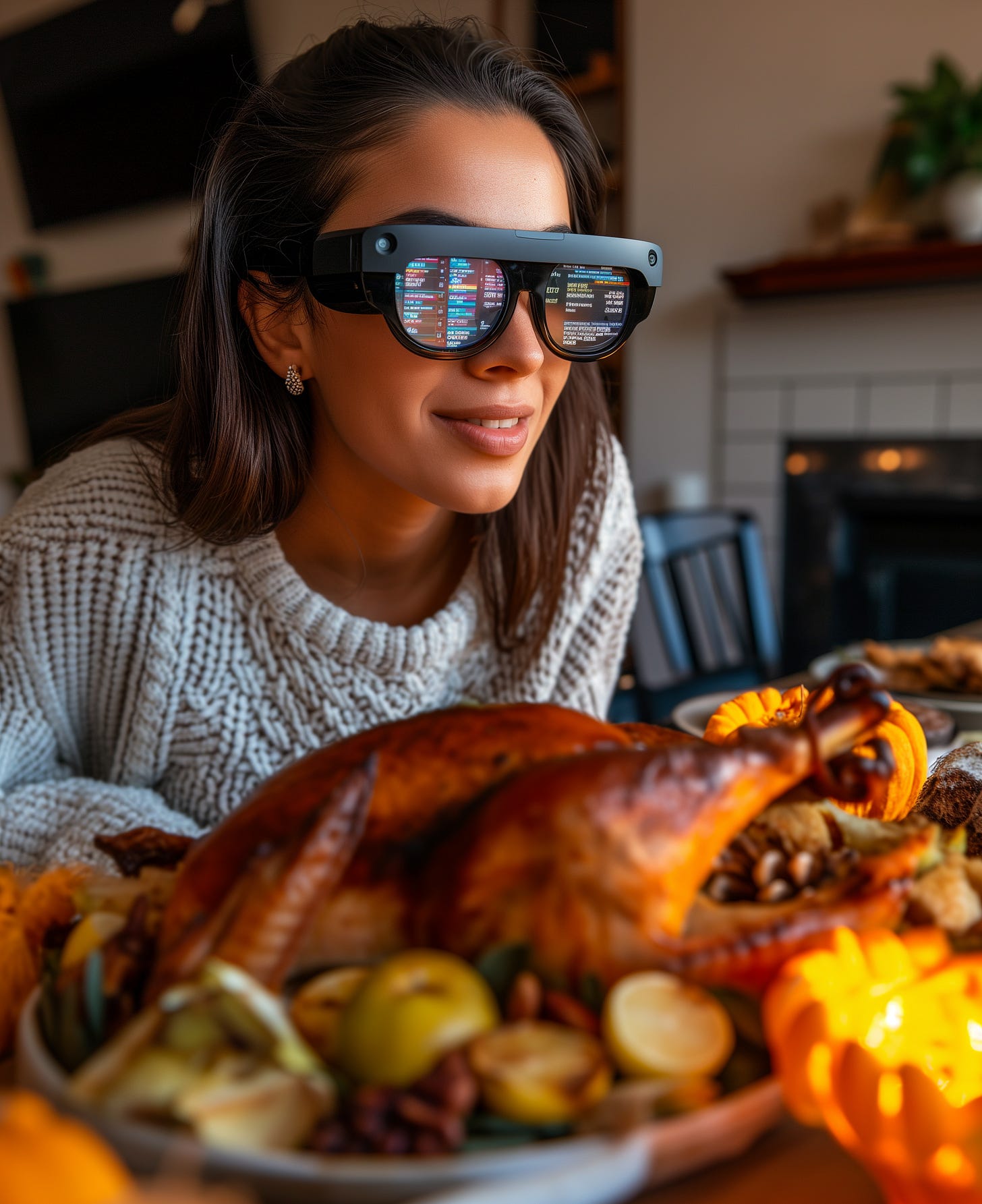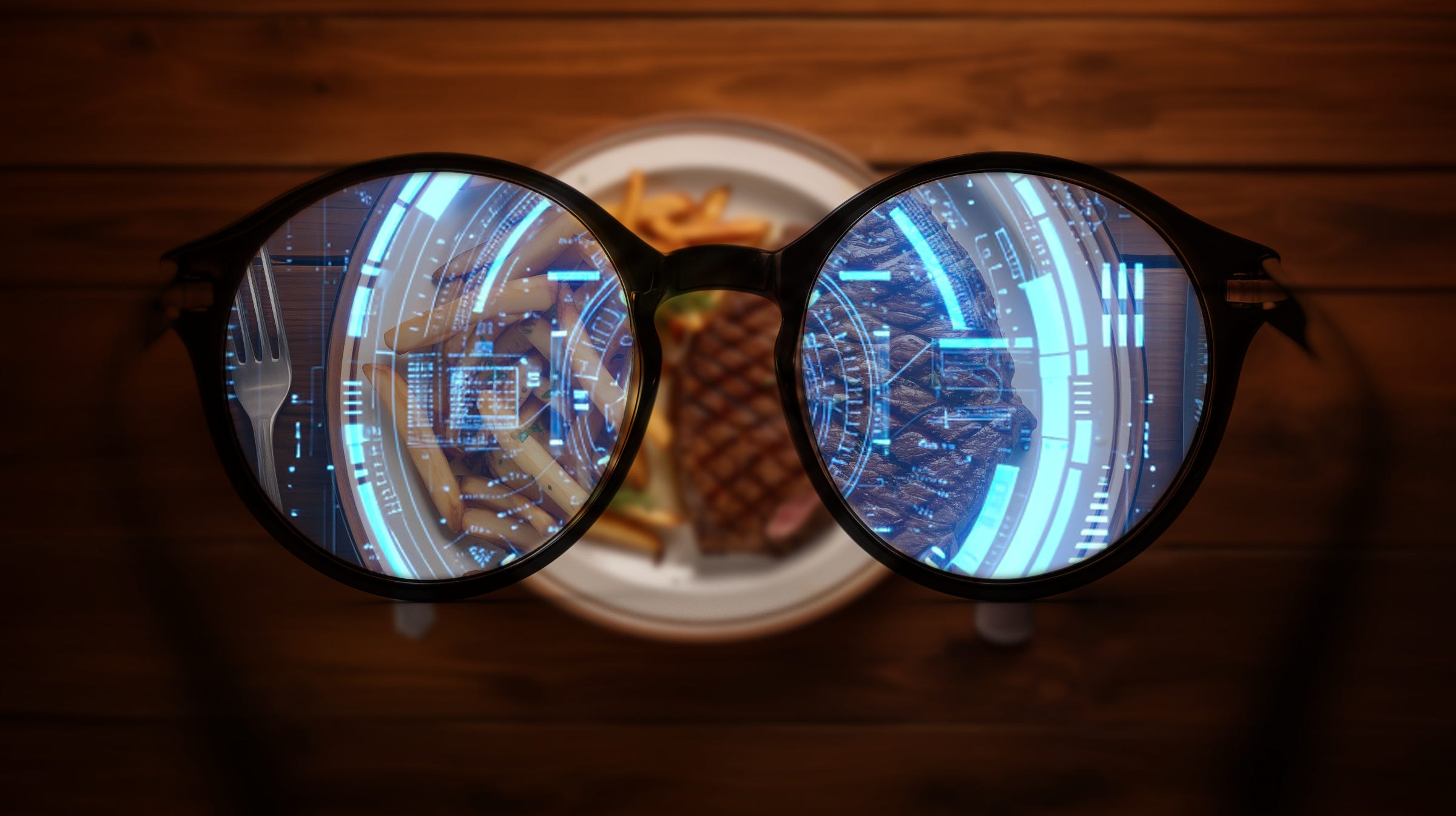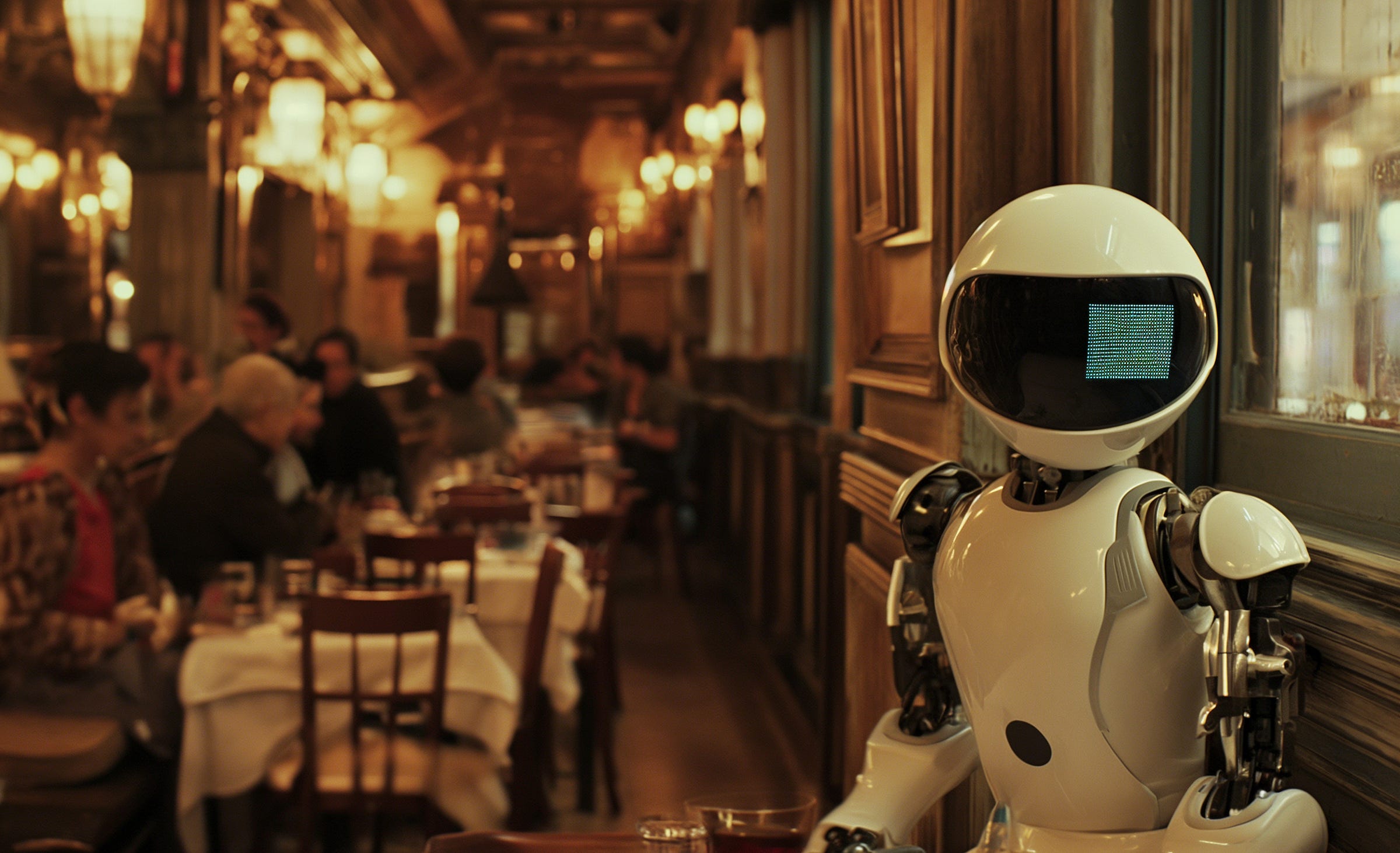BOOK PREVIEW: Algorithmic Appetites
I wrote a book about the future of food and today I’m sharing a preview chapter.
Dear Readers-
Over the past couple months I’ve been putting the finishing touches on my forthcoming book. The book revolves around 8 speculative scenarios about the future of food and agriculture over the next 40 years, from larger than life geopolitical events that will reshape the world order, to intimate portraits of everyday people living and working in a world that’s both familiar and strange to us today.
This isn’t a book in the traditional, linear sense. It’s a cross between a speculative fiction novel, a graphic novel, and a futurist research paper in the format of a 175+ page magazine, complete with some incredible AI generated images that bring the stories to life. It even has full page ads depicting products we might all be buying soon. It’s like you stepped in a time machine to the year 2065 and brought a magazine from the future back with you.
The book is not about current food trends. Rather, it’s an example of the scenario planning work I do for clients, full of insights and visions that will change the way you look at today and the next few years. Some of my best work on the future of food is locked up behind client NDAs, but this is something for the public.
The speculative visions in each chapter will be accompanied by an analysis that links those narratives to events happening in the real world today. It also has recommendations on what the food and agriculture industry can take action on today.
While the book is primarily a work of fiction, it’s narratives are all logically plausible and rooted in today’s headlines, both inside and outside of the food and agriculture industry. The insights will apply to you whether you work in food or not.
The 8 chapters examine the future from a wide range of lenses and are as follows:
Chapter 1: The 2030 State of Big Food and Agriculture
Chapter 2: Cereal Intrapreneur
Chapter 3: The Many Faces of Regeneration
Chapter 4: Just a Spoonful of Snake Oil
Chapter 5: The People’s Green Republic
Chapter 6: The Tian Gao Integrated Pork Cultivation Facility
Chapter 7: Algorithmic Appetites
Chapter 8: The Burlingtons
Below is a preview of Chapter 7, Algorithmic Appetites, which describes a world where personalized nutrition has become a reality in the year 2040. By then, wearable sensors and computers work alongside AI-enabled nutrition recommendation engines to track every single thing we eat, drink, and do in order to guide our food journey.
The book will be released in late March / early April as a high-quality print magazine. Pre-order information will be announced sometime in the next month. I’ll also reveal the name of the book and share images of the printed proofs. If you’re subscribed to my Substack, you’ll hear about it first.
There will be much more to come soon, but for now I hope you enjoy this preview chapter of Algorithmic Appetites.
Yours,
-Mike
Questions or comments?
As always, my email is mike@thefuturemarket.com.
Algorithmic Appetites
Year 2040
The dream of personalized nutrition and the quantified self had finally come true. For decades, researchers wrestled with the difficult problems of measuring a person’s entire food intake and physiological data, then making sense of it all in real time to give useful dietary recommendations.
While smart health wearables had come a long way and could automatically measure a plethora of useful body metrics, tracking food intake was typically done manually, with eaters having to self-record everything they ate on paper or via app. Accuracy was general at best, as the arduous task of listing every food ingredient and quantity consumed was too much for the average person to sustain. And even if someone had a perfect database of their food intake, there was no precise way to understand the causal relationships between a person’s diet and the effects on their body at a granular level.
But the advances in machine learning, biological sensor technology, and nutrition science over the past 30 years turned the idea of a real-time personalized nutrition assistant from science fiction to science fact. With a small embeddable sensor attached to a person’s stomach lining, recording the entirety of someone’s food and drink consumption 24/7 became easy. This huge amount of unstructured data was relayed via a microscopic 7G transmitter in the person’s stomach sensor, to a datacenter that processed it all with machine learning software running on powerful AI hardware.
The stomach sensor was the core of the personalized nutrition hardware stack, but eaters had a wide range of additional sensors to wear or embed that would gather additional data to make nutrition recommendations even more meaningful. Smart watches, smart rings, heart monitors, and brain sensors could all contribute data that gave the algorithm a more complete picture of a person’s body state. Smart toilets and embedded colon sensors could analyze bowel movements to better understand how much nutrition was being absorbed in a person's body. And image recognition glasses or contact lenses could increase the accuracy of the stomach sensor by seeing and classifying the food before a person ate it. There were so many add-on accessories to choose from.
All this data was consolidated in a digital dashboard that provided as many food recommendations as an eater wanted, depending on their goals. Elite athletes training for competitions wanted maximum control and relied on these systems to provide them with precisely formulated meals to maximize performance. They would install as many sensors as possible into their bodies and adjust their software settings to be more exacting, which would provide recommended food intake down to the gram.
More casual users might just opt for a basic stomach sensor and smart health watch to stay generally healthy and keep the pounds off, while still enjoying a wide range of foods. They still had a lot of control over how rigid their dietary planning would be, instructing the software to be more precise and healthy for their weekday meals, while allowing for looser recommendations on the weekends to let them indulge a little. Users could also adjust their food recommendations according to the cuisines they most liked and how much serendipity they wanted in their diet. Some people wanted the comfort of eating the same things over and over again, while others loved the surprise of trying new foods. Just because a robot was making your meal plans didn’t mean you had to eat like one.
Food recommendations could be outputted to any number of food prep resources. People with the time and talent to prepare all their meals at home would get detailed grocery lists of the foods they needed, which could be procured manually or delivered from their favorite store. All the major food delivery apps were integrated into the system as well, and those short on time would have ready to eat meals dropped off at their doorstep. Home food fabrication technology was still nascent, but advocates of those technologies hope that one day people could grow highly customized proteins in kitchen countertop bioreactors while produce was grown in indoor soilless growing appliances.
In 2035, smartphone manufacturers began shipping their latest models with built-in mass spectrometers that could analyze a food’s nutritional content. The technology had been in development for nearly 20 years and was finally mature enough to quickly provide accurate data on macro and micro nutrients for a wide range of foods. It was an all-too common scene to watch grocery shoppers holding their phones over pieces of produce and placing the most nutrient dense ones in their carts and pushing the rest aside.
Citizen science like this sent a reverberating effect up the supply chain, as farmers needed to optimize the nutritional density of their crops to meet the high standards of retailers and eaters. In some high end grocery stores where customers were especially demanding, food waste increased considerably at first because customers weren’t buying produce that had high enough nutritional content, as measured by everyone’s smartphone scanners. But most farmers adjusted their growing methods and produce quality increased significantly.
Personalized nutrition tools were not without controversy. A growing number of parents with young children were asking their pediatricians to install stomach sensors to better track and optimize their diets. Some extreme parents would even install these sensors in their babies just hours after being born. Parents have always wanted the best for their children and have been neurotic about their kids’ diets since the early 2000s. So it was of little surprise that when these tools were approved for use in children, parents were eager to use them. Critics of this practice were up in arms that parents would alter a child’s body before the child was old enough to make their own decision. They compared it to giving your baby a tattoo or body piercing as an infant—a clear violation of that child’s body autonomy.
Even though the sensors could easily be removed in a quick and painless outpatient procedure, children who grew up with personalized nutrition technology had a different connection with food than kids who ate the old-fashioned way. There was anecdotal evidence that these tools were causing higher incidences of eating disorders and heightened anxiety about food. One teenager became bulimic after growing up with a stomach sensor since age 2, then at 13 when she decided to remove it, she found she was second guessing everything she ate. She never had to make her own food decisions and now that she was off the personal nutrition stack, she would eat a meal then feel so much remorse that she forced herself to vomit it up. Growing up with the idea that there is one kind of perfect meal for you put so much pressure on her that it was hurting her physical and mental health once she didn’t have the algorithm to rely on.
Nutrition software companies responded to many stories similar to this by adding even more features in the system settings that empowered users to calibrate how exacting the food recommendations were. More food options were given as potential ways to reach a target nutrient level in a day and users could prioritize just a couple key nutrients, like protein or calcium, to avoid worrying about having to eat a laundry list of nutrients every day.
Restaurants had to change too in light of this new technology. Some hardcore users would only visit establishments that were personalized nutrition compatible, usually signified with a bright orange sticker bearing the official icon for personalized nutrition technology placed on health department grade signage. Digital menu tablets would automatically sense a user’s stomach sensor nearby and after the diner granted sharing permissions, the restaurant would receive all relevant eating data on the guest.
Long gone were the days of having to inform restaurant servers of one’s dietary restrictions and allergies, as this was all seamlessly communicated to the server and kitchen staff digitally. Once the information was transferred over, a diner’s digital menu would filter out all the items that didn’t fit the nutrition profile of that diner. High quality restaurants would pride themselves on the level of food customization they could do for a diner. The best ones would ask for personal nutrition data during the reservation booking so the chefs could create a fully customized tasting menu for that guest. But even humble mom and pop cafes and diners would keep their regular customers’ food data on file alongside a few favorite menu items tailored to their needs. So whether you were out for a special birthday dinner or just grabbing a sandwich during your lunch break, your dietary needs could be accurately met in a seamless way.
On the other hand, there were certain well-known chefs who were repulsed by the idea of having such a rigid set of requirements and forced their diners to put their nutrition apps and devices into “celebration mode.” Once in celebration mode, the diner was temporarily off the grid when it came to food intake and anything consumed would not be recorded. These chefs held themselves in high regard and felt that these tools compromised their culinary vision. They wanted their restaurants to be places where people could let go of inhibitions and be more human.
In a similar vein, while most bars and nightclubs didn’t require celebration mode, patrons would routinely turn it on when they were out for a night of drinking and late night eats. Many vacation resorts and cruise ships strongly encouraged celebration mode too, nudging them to eat and drink to their heart’s content during their stay. Longstanding users of personalized nutrition software felt that regularly going into celebration mode was crucial for long term adherence to the program. After all, food was as emotional as it was logical and the secret to staying on a personalized nutrition regimen was to get off of it periodically…












